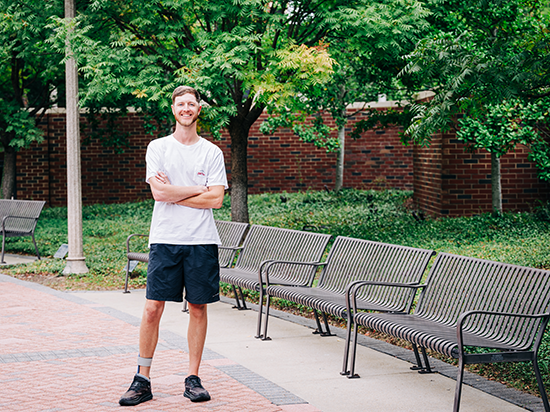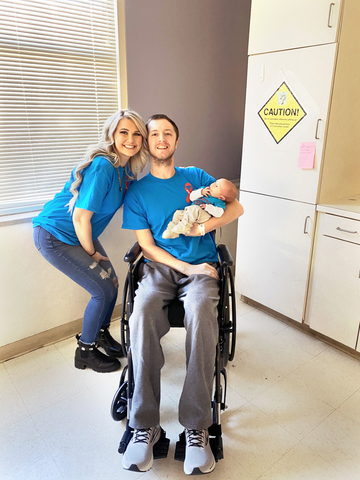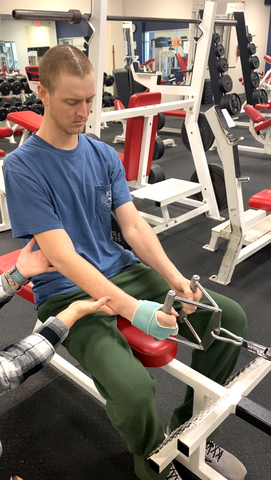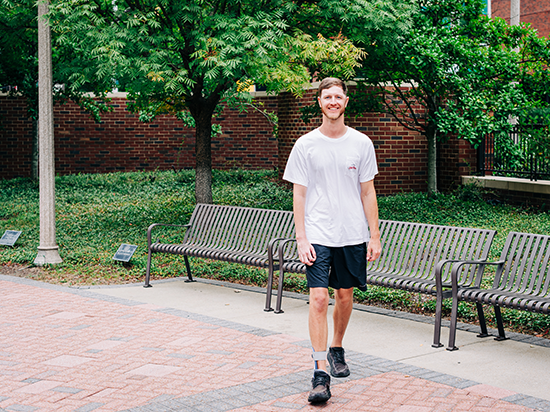 Two years after his stroke, Blake Crumpton continues to attend therapy sessions and take steps to regain his independence.
Two years after his stroke, Blake Crumpton continues to attend therapy sessions and take steps to regain his independence.
Photography: Andrea MabryAt 1:13 a.m. on Sept. 19, 2022, Haley Crumpton woke up out of a dead sleep to find her then 29-year-old-husband Blake completely unresponsive.
His breaths were shallow and, at times, nonexistent. Haley, who was eight months pregnant at the time, immediately called 911 and was instructed to start doing chest compressions. She continued doing chest compressions until first responders arrived. On the way to an area hospital, Blake’s heart stopped multiple times and had to be restarted. He had gone into cardiac arrest, leading to heart failure and renal failure due to the lack of blood flow in the body.
Blake was transferred to a Birmingham-area hospital, where he underwent a procedure to implant a heart pump and restore his heart function back to normal. He was then transferred to the University of Alabama at Birmingham. Doctors at UAB Medicine conducted a CT scan and found swelling in Blake’s brain. Blake had suffered a major stroke to the left half of his brain.
“After the doctors determined Blake had suffered a major stroke, they were reluctant to say whether he would ever be able to walk or talk again,” Haley said. “They also were not sure if he would be able to recognize us when he woke up.”
He was immediately rushed to the operating room for emergency surgery to relieve the swelling on his brain.
“We had to address the swelling quickly or it most certainly would have been fatal,” said Elizabeth Liptrap, M.D., a neurosurgeon and assistant professor in the UAB Department of Neurosurgery. “We removed a portion of his skull to allow the injured brain the room it needed to swell without hurting the rest of the brain. After several months, the swelling subsided, and Blake was able to have a skull implant to completely cover the defect.”
 While Blake was at Spain Rehabilitation Center, Haley went into labor and gave birth to their baby boy. The day he got to see his son, Blake says, he was so happy and felt so much love.
While Blake was at Spain Rehabilitation Center, Haley went into labor and gave birth to their baby boy. The day he got to see his son, Blake says, he was so happy and felt so much love.
Photo provided by Haley CrumptonHaley and Blake have their first child together
On Oct. 30, 2022, while Blake was at Spain Rehabilitation Center, Haley went into labor and gave birth to their baby boy.
“It was a very stressful time knowing I was going to have to leave him when I went to have our son,” Haley said. “It was also hard having our first child together without him there. But overall, I was just thankful that he was still alive to be able to help raise our son with me down the road. Even though he could not be there the day he was born, it allowed him to be able to be there in the future.”
Little did they know, at just a few days old, their baby would already begin to play a huge role in Blake’s recovery.
The day he got to see his son, Blake says, he was so happy and felt so much love. While Blake was already motivated to get better, Haley says their newborn motivated him to get better as fast as he could. Each day, Haley would upload images of the baby to a digital picture frame in Blake’s room.
“Every morning, Blake looked at pictures of his newborn son in his hospital room, and that provided him the motivation he needed to do his therapy sessions for that day,” said Xiaohua Zhou, M.D., Blake’s physiatrist at Spain Rehabilitation Center.
Road to recovery
“It is not very common to see a person Blake’s age have a devastating stroke like this,” said Zhou, an associate professor in the UAB Department of Physical Medicine and Rehabilitation. “Fortunately, because of his age and motivation with great family support, his prognosis was good. We worked with him to set up both short-term and long-term goals as he progressed in his recovery.”
 Blake's treatment plan included physical, occupational, speech and music therapy to work toward recovering some of the skills he had lost due to the stroke.
Blake's treatment plan included physical, occupational, speech and music therapy to work toward recovering some of the skills he had lost due to the stroke.
Photo provided by Haley CrumptonZhou set up a treatment plan for Blake that included physical, occupational, speech and music therapy to work toward recovering some of the skills he had lost due to the stroke. At the beginning of his therapy, Blake was unable to talk or move his right side.
“For patients with neurologic dysfunction, we have a sweet spot the first six to 12 months to see the most neuroplastic changes,” said Gabi Camacho, one of Blake’s physical therapists. “Blake’s sessions in the hospital were basically like bootcamp. We tried to push the body as much as we could to help him gain as much function back as he could. Blake was young, alert and motivated and had a strong support system, so he was a great candidate for high-intensity training.”
Blake’s therapy first began with electrical stimulation to try to get his nerves firing and therapy exercises focused on standing and bearing weight on his right leg. Once he started bearing weight on his legs, they progressed toward high-intensity step training for one and a half hours every day. He soon progressed to having a combination of physical, occupational and speech therapy for four hours a day. Blake says the day he took his first steps was both hard and emotional, but he continued to keep pushing forward for his family.
“I can count on one hand the number of people who had the type of motivation and determination in their recovery that Blake had,” Camacho said. “Every day, he was ready for therapy and would even come down for extra therapy, so he could get in as many steps as possible each day. Every time I see him, he is getting better and better, and it really is so rewarding to see the progress he has made.”
In addition to physical, occupational and speech therapy, Zhou also prescribed recreational therapy including gaming, arts and crafts, and music therapy.
“The speech center is located in the left side of the brain,” Zhou said. “After his stroke, Blake worked with his speech therapy team at Spain Rehab Center. He had a very severe form of aphasia to the point he had no ability to talk, understand what was being said to him, read or write. He also had a severe apraxia, causing difficulty planning and coordinating mouth movements. Because the right side of the brain controls music/melody, we incorporated music therapy into his daily rehab by using his favorite music as a method of inducing speech. Through his hard work and his family’s support, we saw significant improvement in his understanding and talking with supported communication.”
 Some of Blake's proudest accomplishments since his stroke include learning how to walk again and how far he has come with improving his comprehension and speech.
Some of Blake's proudest accomplishments since his stroke include learning how to walk again and how far he has come with improving his comprehension and speech.
Photography: Andrea MaryBlake celebrates 30th birthday at home
After two months in the hospital, Blake was sent home on Nov. 18, 2022 — the day before his 30th birthday. Since Blake has been home, he has continued to attend therapy sessions and take steps to regain his independence. Today, nearly two years after the incident, Crumpton is now walking independently, and his speech has improved tremendously. He is starting to regain function in his right arm, which was impacted due to the stroke.
“Throughout this experience, Blake’s determination has really impressed all of us,” Haley said. “It was very hard for him to go from being a very active person to learning how to walk again; but Blake has shown that, with determination, you can get better.”
Blake says some of his proudest accomplishments since his stroke include learning how to walk again and how far he has come with improving his comprehension and speech.
“The fact that Blake has progressed so quickly in his recovery in such a short amount of time is really phenomenal,” Liptrap said. “Unfortunately, people who have a stroke as severe as his do not always learn to walk, speak and comprehend language again, and he is doing all three. He can definitely be considered a miracle.”